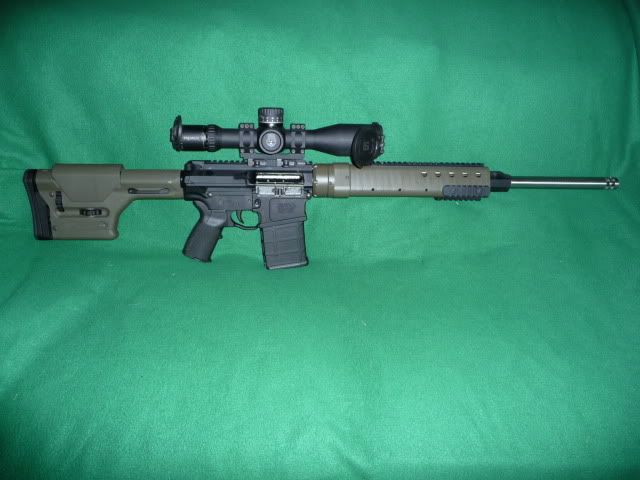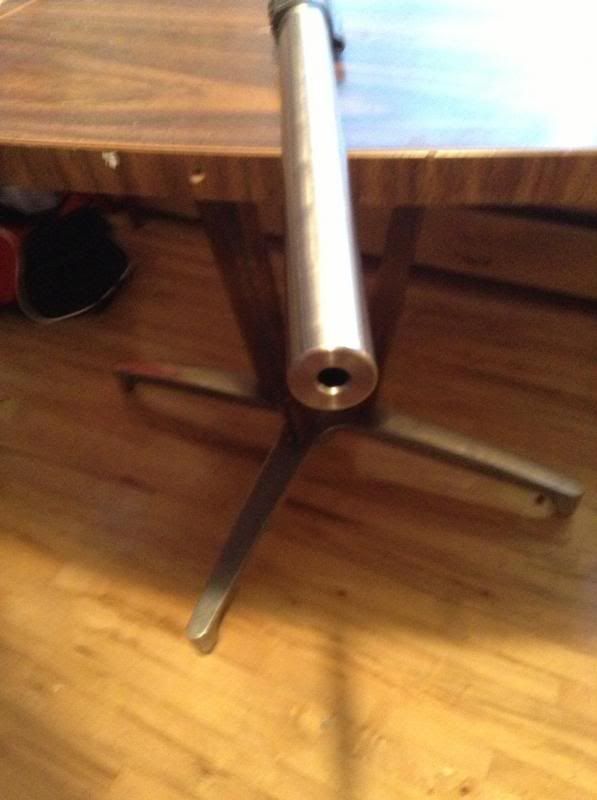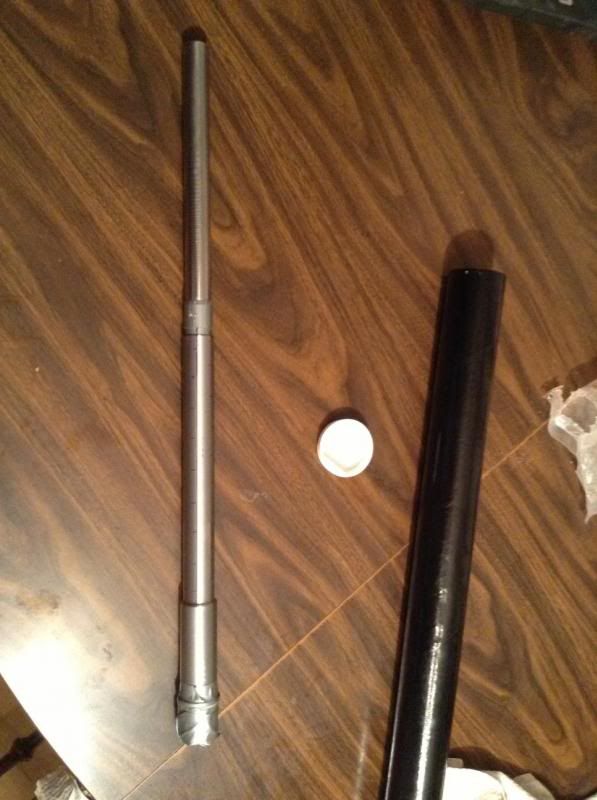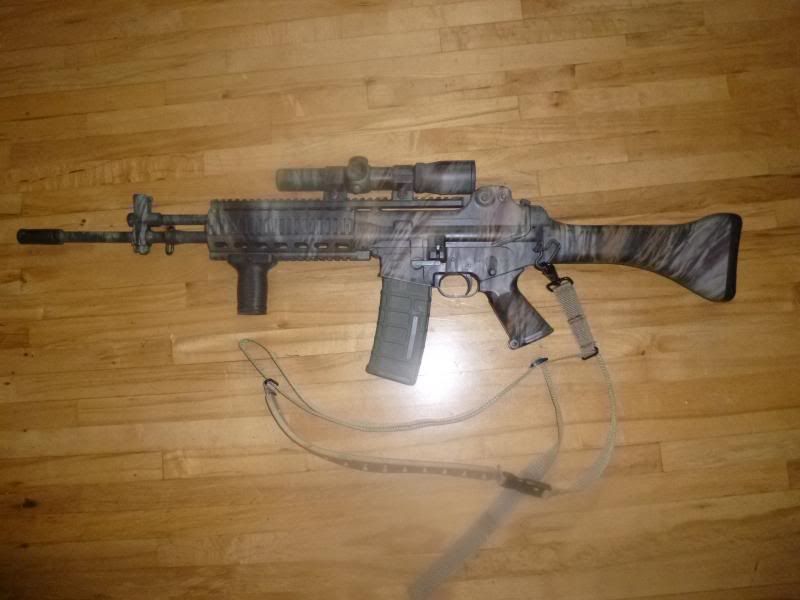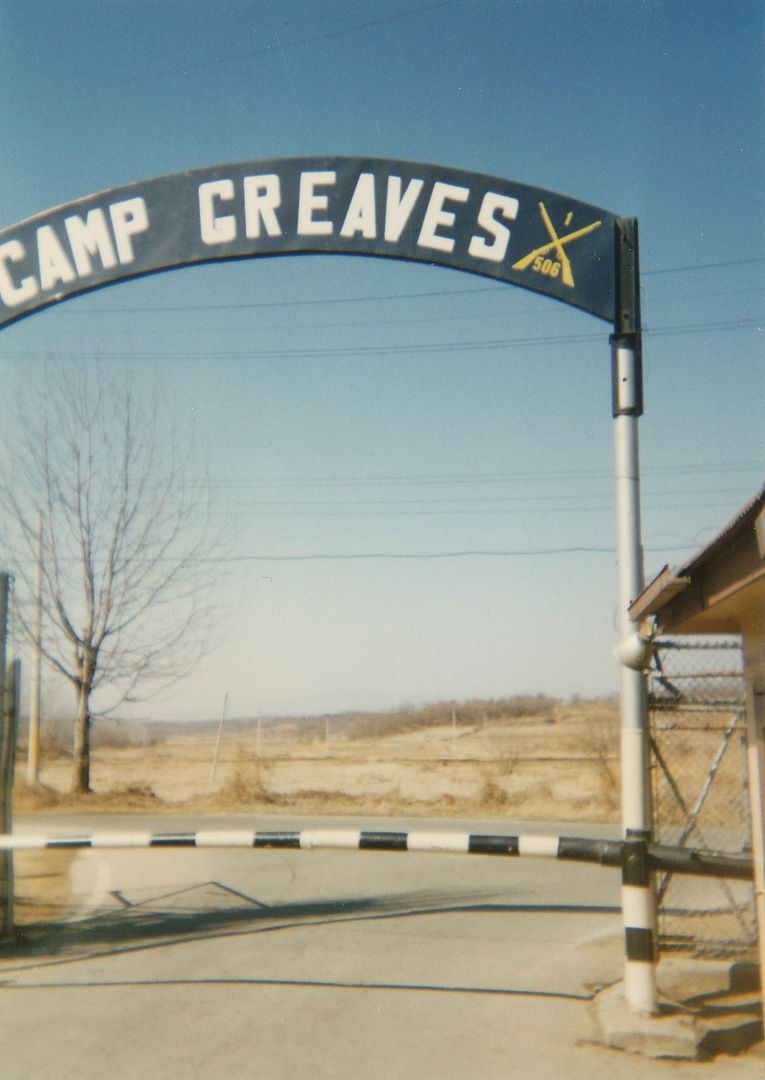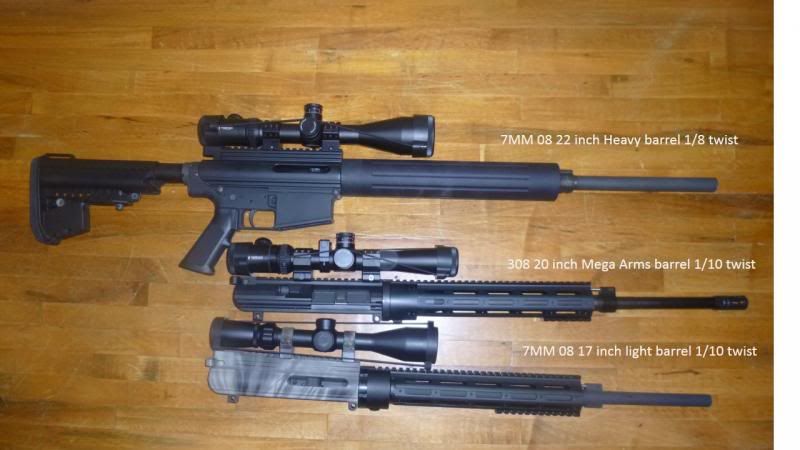Found this
7mm-08 Remington
History
First experimented with by Wildcatter’s, the 7mm08 is based simply on the .308 Winchester case necked down to 7mm. The original wildcat was utilized by both hunters and target shooters, gaining greater attention in the target shooting arena. Based on popularity, Remington officially adopted the cartridge in 1980 without any changes to the wildcat name or design.
After its formal introduction sales of 7mm08 rifles were modest but in no way an immense success. It was not until the mid to late 1990’s, the beginning of the ultra lightweight rifle trend, that the 7mm08 became a focal point for both hunters and retailers. Since 2000, the 7mm08 has absolutely soared in popularity. The cartridge is often promoted by retailers as having light recoil yet high down range energies while being available in light weight rifle platforms.
The 7mm08 is also enjoyed by a newer type of western hunter, generally speaking, by those who have great work commitments and little time to hand load or practice hunting and shooting with higher recoiling rifles. The cartridge is supported by an abundant range of full pressure yet mild powered factory ammunition, ideally suited to medium game hunting.
In competition circles the 7mm08 has lost a great deal of ground to the 6.5’s. Although the 6.5 bore has the potential to produce excellent exterior ballistics combined with minimal recoil, bore selection for match shooting has been and always will be equally effected by fashion trends and subjective experience.
Performance
The 7mm08 is often promoted as having a flatter trajectory than the parent .308 while producing less recoil. Unfortunately it is easy to take the above comment out of context. Like the 7mm08, the .308 can be loaded with a range of high BC projectiles which produce desirable trajectories and both are exceptionally useful cartridges. The .308 is somewhat more flexible where a heavy bullet is needed or wanted for use on large animals. With 140 grain hunting bullets the 7mm08 is flatter shooting than the .308 loaded with 150 grain hunting bullets, showing an advantage as a lighter medium game hunting cartridge when utilizing factory loaded ammunition.
One of the greatest traps regarding the 7mm08 has been a range of lightweight rifle designs that produce often intolerable recoil, recoil similar to that of a standard weight .300 Magnum. A large number of hunters are currently ‘enduring’ the recoil of the 7mm08 without knowing that what they are experiencing is unnecessary.
Generally speaking, most current factory 140 grain 7mm08 loads achieve 2800-2840fps from 22” barrels. Killing performance tends to duplicate the 6.5x55. At close ranges, wounding on medium game is broad and kills are very fast. At ranges beyond 150 yards, as velocity falls below 2600fps, kills can be delayed. On tough animals, kills may be so slow as to allow animals to escape great distances.
At the a fore mentioned ranges beyond 150 yards and using factory 140 grain ammunition, the hunter should aim to break the foreleg bones of game. Both rear lung and neck shots from various brands of 7mm08 ammunition often result in very slow killing at extended ranges. With care to shot placement, the 7mm08 gives excellent results and like the 6.5x55, it is all too easy to become lulled into a false sense of security. It is therefore not unusual to have a string of successes followed by an abysmal failure after neglecting the above mentioned shot placement.
With many 140 grain 7mm08 factory loads, penetration is poor on tough medium game. To some extent, both the demand and expectations of the 7mm08 are so high that ammunition manufacturers are asked to produce the impossible. As a compromise, to promote fast killing at ranges of 200 to 400 yards, loads are designed to produce explosive wounding for the fastest possible kills rather than deep penetration and exit wounding on tough game. Hunters must therefore set realistic expectations of factory ammunition performance.
With hand loads, the hunter has a huge range of options and can tailor loads to suit a variety of situations. From the typical 22” barreled production sporting rifles, velocities for 140 grain loads are usually around 2800-2840fps, about 80fps slower than the 7x57 due to the difference in traditional barrel lengths. The 140 grain bullets lose velocity quickly and beyond 150 yards, the effects of various bullet designs become more pronounced.
Heavier 154-162 grain 7mm bullets often produce the most consistent results in the 7mm08 across a wide range of game body weights and ranges. The only downside of this approach is that at a theoretical level, the lower velocity of a 154-162 grain bullet seems to go against everything hunters have striven towards for the last 100 years - high velocity as a means to produce fast killing.
Each cartridge has its own performance parameters and using a slower, yet higher BC bullet in the 7mm08 does not in any way remove killing power or limit trajectory within this cartridge’s existing limitations. This
is not the same theory as the slow moving heavy bullet practice relative to big bore performance or 20th century ballistics theory. Rather, it is simply a method of utilizing current bullet designs, particularly the sleek, soft 162 grain A-max. The A-Max allows the hunter more error with shot placement at extended ranges as rear lung wounds are usually so severe that game cannot move far once hit. At the same time, velocity from the 7mm08 is so mild as to not cause shallow penetration with point blank range raking shots.
Factory Ammunition
Although Remington adopted the 7mm08 as their own, this company have produced some very poor performing 7mm08 ammunition over the past few decades. Fortunately, due to intense competition, modern loads are much more potent than before. Current loads include the 120 grain hollow point at 3000fps, the 140 grain Core-Lokt at 2860fps and the 140 grain Accutip, also at 2860fps.
Remington’s 120 grain hollow point is designed for varmint hunting but is adequate for game as heavy as 40kg (90lb). The 140 grain Core-Lokt load has a jaded history. Initial velocities for this load were very low and produced poor case neck to chamber obturation along with excessive powder fouling at the neck and throat area of rifles. The compacted powder residues raised pressures while destroying accuracy. Velocity was in the region of 2650 to 2750fps and with the extremely poor BC of .390, the Core-Lokt load did not run true to the advertised claim that the 7mm08 produced superior ballistics to the .308.
The current 140 grain Core-Lokt load achieves a velocity of around 2800fps in 22” barrels, slightly but insignificantly lower than 24” test barrel velocities. While its BC may be poor, performance on game out to moderate ranges is excellent. For hunters who seldom take shots beyond 200 yards, the Core-Lokt is inexpensive yet highly effective, producing both broad wounding and reasonably deep penetration with minimal risk of jacket core separation.
The more recently introduced 140 grain Accutip is quite different to any former Remington loadings. Remington made an effort to ensure this load achieved maximum velocities along with desirable longer range performance. The only downside is that this load is terribly expensive for U.S hunters, let alone export countries where one packet of Accutip ammunition can cost the same as a weeks groceries for a single man.
At close ranges, the Accutip (which is most likely a re-branded SST), produces immensely traumatic wounding on medium game. This is not an Elk bullet, doing its best work on all game up to weights of around 80kg (180lb). Penetration is fair at close ranges although retained bullet weights tend to be lower than 50%. At longer ranges, the Accutip can suffer jacket core separation but at such ranges (250 yards and beyond), this behavior is not usually detrimental to wounding as the bullet fragments are large and lethal. From a velocity of 2840fps, the Accutip does its best work inside 250 yards (2400fps). Beyond this range the bullet design and power of the 7mm08 limit wounding although kills are normally clean, even if delayed. Performance is reduced further at 375 yards or 2200fps.
Federal have really gotten behind the 7mm08 in recent years and now produce several useful loads. These include the 140 grain Nosler Ballistic Tip at 2800fps, the 140 grain Accubond at 2800fps, the 140 grain partition at 2800fps, the 140 grain Barnes TSX at 2820fps, the 140 grain Fusion at 2800fps and finally, the 150 grain Speer Hotcor at 2650fps. For unknown reasons, all of these loads achieve velocities faster than the above advertised specifications regardless of the fact each were developed in a 24” test barrel. From typical 22” barreled sporting rifles, Federal’s 140 grain loads achieve 2840fps while the Hotcor achieves an outstanding 2750fps. None give excessive pressure and all have the potential to produce outstanding accuracy in suitably tuned rifles.
The 140 grain Ballistic Tip is, as can be expected, a general purpose open country load. Wounding is thorough and violent at closer ranges, killing is clean but in no way spectacular. For smaller species of Whitetail and other game of this size, the BT is an ‘adequate’ performer out to ranges of 350 yards. On small but tough animals such as pigs, the BT can be quite shallow penetrating and wounding limited by the power of this cartridge. It should be noted that Nosler’s original ideal bullet design was the Partition, the Solid base and later the Ballistic Tip created to meet trends, rather than performance orientation.
The Accubond is another humble performer producing wide internal wounding and clean killing but with relatively deep penetration. Hunters should not expect exceptionally deep penetration with this bullet as it has a very low SD. As a medium game bullet, the AB is a good all-rounder.
The 140 grain 7mm Partition is much like the Accubond, both produce a wide wound regardless of the focus towards optimum controlled expansion within each design. Again, a low SD as a result of the 140 grain 7mm bullet weight dictates that for best performance, the Partition and Accubond do their best work on game weighing up to 80kg (180lb). Both bullets are adequate for game up to 150kg (330lb) but this weight should be considered a maximum. The Accubond and Partition often produce surprisingly good performance at lower velocities of 2200fps or 300-350 yards providing game are not too lean.
The stoutest bullets in the Federal line of ammunition are the 140 grain Barnes TSX and the 140 grain Fusion loading. The Fusion bullet is a very odd, almost rushed design. At close ranges upon impact, the Fusion will often fail to impart any measure of hydrostatic shock and game can appear quite unaffected by well placed shots. After impact on medium game, the bullet expands, produces a quite normal wound channel (similar to other 7mm 140 grain bullets) while gradually breaking down until very little is left of the original projectile. The broken off fragments tend to be small, often less than 1mm (40 thou) in diameter. To this end, the Fusion is neither a fast killing or deep penetrating projectile.
The 140 grain TSX is undoubtedly a deep penetrating projectile, able to take a 1200lb animal broadside, although, such a practice should be considered unethical due to the small diameter of the wound. Nevertheless, this bullet is the best choice in the 7mm08 for tough game weighing between 90 and 320kg (200-700lb).
On lighter medium game, the TSX is a little too stout for all round work. This does not mean that the Barnes does not readily expand, to the contrary, wounding through vitals is ideal. The only problem with using this projectile on lighter game is that the trauma does not also occur immediately upon impact or during exit wounding. Kills at impact velocities below 2600fps and especially below 2400fps can be very slow as a result. If the TSX is to be used on lighter medium game, bullets should be placed to break major bones and locomotive muscles in order to effect immediate incapacitation.
Federal’s heavy weight load for the 7mm08 utilizes a proprietary 150 grain Speer Hotcor bullet with a cannelure, a design feature which is not normally available to hand loaders. This is one very good medium game loading. The Speer opens up quickly on impact, produces a wide wound channel before expansion is arrested by the cannelure. Penetration is slightly better than the Fusion load which costs twice the price of the budget branded Hotcor loading and is on par with the Partition and Accubond loads.
Winchester produce two loads for the 7mm08, the 140 grain Power Point at 2800fps and the 140 grain Ballistic Silvertip at 2770fps. Both are humble performers offering rapid expansion but limited penetration.
Hornady currently list two Superformance loads. These include the 139 grain SST at 2950fps and the 139 grain GMX at 2910fps. Like the former Light Magnum loadings, the Superformance ammunition gives ‘true to advertised’ velocities in 24” barrels. As is almost always the case, shorter barrels lose 35fps per inch of barrel removed. In standard 22” sporter barrels, the SST at 2890 is slightly faster than Federal loads and also slightly faster than can normally be achieved with hand loads.
The 139 grain SST is very hard hitting out to 250 yards (2400fps), producing a wide, violent wound. Penetration is reasonably good at impact velocities above 2600fps (150 yards) due to the swaging/forming of a uniform mushroom, although the 139 grain SST is unsuitable for tail on shots on light bodied game. At longer ranges, the 7mm 139 grain SST projectile is prone to suffer jacket core separation however cross body and quartering wounding is usually more than adequate. The GMX is, like the Barnes TSX, better suited to heavier animals above 90kg (200lb) as opposed to all round use, simply because on light game, even though wounding can be broad, the delay in killing can lead to difficulty tracking dead run game.
Reloaders logo.jpg
Hand Loading
The 7mm08 is often compared with the original 7x57 with regard to which is the more potent of these two mid powered cartridges. Some hunters have posed the question - “was there any need for the 7mm08?” The 7x57 certainly has a longer case with a longer neck than the 7mm08. Rifles chambered in 7x57 also have a longer free bore and longer magazines than the 7mm08, adding versatility when using 160 to 180 grain bullets. Having said this, the 7mm08 utilizes the minimal body taper and over all efficiency of the parent .308 Winchester cartridge. To this end, variations in individual rifles close the gaps between the 7mm08 and 7x57 considerably and it is not uncommon for 22" barreled 7mm08 rifles to duplicate various 24” barreled 7x57 rifles as can happen vice versa. If one were to really push the point, the .284 Winchester is more powerful than either and more the underdog if there is to be a prize for the most deserving of acclaim.
The 7mm08 gives best results with the same powders used in the 7x57, Varget (ADI 2208) works best with 120 to 140 grain bullets while the 4350 burn rate powders work well with heavier bullets or long barrels Realistic velocities from a 22" sporter are 3050fps with 120 grain bullets, 2850fps with 140 grain bullets, between 2750fps with 150 grain bullets, 2650fps with 160-162 grain bullets, 2550-2600fps with the 168 grain Berger VLD and 2450fps with 175-180 grain bullets.
One interesting factor is that all Federal factory loads achieve higher velocities from 22” sporting barrels, than the velocities achieved in various reloading manuals. As always, experimentation is the key towards developing high velocity combined with acceptable pressure and excellent accuracy.
Competition shooters generally adopt barrel lengths of up to 32” for the 7mm08. With slow burning powders, velocity gains between 22” and 28” are generally 35fps for a cartridge of this capacity. Long range hunters will also sometimes adopt long barreled rifles chambered in 7mm08 and in doing so, recoil is reduced to extremely low levels.
Due to the fact that the 7mm08 and 7x57 are so similar in potential velocities, all reloading component bullet performance has been discussed in the 7x57 text. To recap; the 120 grain bullet weight is best suited to the lightest of game species (under 40gk/70lb) due to limited penetration. Most 139/140 grain 7mm bullets produce good, but not outstanding performance. Of the current 140 grain bullet designs, the 140 grain Hornady SST is the most dramatic killer on lighter weight medium game, the Hornady InterBond and Nosler Accubond have high BC’s, but give deeper penetration than the SST and can be slightly more effective on medium sized yet tough game.
The 150 to 154 grain bullet weight can be very effective in the 7mm08 when used on game weighing around 90kg (200lb) out to moderate ranges. The 150 grain Nosler Partition is an excellent medium game killer. For those wanting higher down range energies via high BC’s, the 154 grain SST/InterBond combination work extremely well together, the SST performing better at impact velocities of between 2600fps to 2200fps, the InterBond performing well at woods ranges. The 154 grain SST is somewhat unique in its ability to produce wide wounding if major bones are struck at impact velocities below 1800fps however it can be difficult to ensure a bone strike in higher winds at long ranges.
The 160-162 grain bullet weight is very useful in the 7mm08 providing bullet construction is matched to game weights. The 162 grain Hornady A-max is an immensely useful all round bullet, performing well at both close and long ranges on light to medium weight game. Tougher projectiles like the outstanding 160 grain Nosler Partition and Accubond projectiles do their best work on large medium game such as Elk, at close to moderate ranges.
For tough game weighing between 150 (330lb) and 320kg (700lb), the 140 and 150 grain Barnes TSX projectiles produce an excellent combination of broad wounding versus deep penetration in the mild sevens. The 160 and 175 grain Barnes TSX projectiles produce exceptionally deep penetration but limited wounding potential at 7mm08 velocities and are best suited to the largest of game, above 450kg (1000lb). The 7mm08 and 7x57 are not particularly well suited to use on large, heavy game due to narrow chest vital wounding, regardless of deep penetration. For this reason, even if using a tough bullet like the TSX or monolithic solid, neck or head shots on large game are always the most humane method of killing.
Closing Comments
The 7mm08 has seen an immense rise in popularity, beginning with the trend towards ultra light rifles in the mid to late 1990’s, growing further with the collapse of the U.S property market in 2006, marking the beginning of the Global recession of 2007-2010. Although the 7mmWSM could have knocked the 7mm08 off the market a long time ago, factory ammunition for the 7mm08 has been much cheaper to obtain during the recent world wide financial troubles. The problem of ammunition costing was also compounded by China’s demand for raw materials, causing a dramatic rise in metal costs from 2005 onwards.
As for the light weight rifle trend, the 7mm08 was for some time the most preferred light weight high power rifle chambering for hunters that climbed to the highest, most dangerous peaks in search of alpine game. Today, the larger magnums are becoming more acceptable to such hunters due to advances in technology such as ballistics software, enabling longer range shooting. Nevertheless, the 7mm08 retains a number of fans, many having hunted with this cartridge for most of their hunting careers. The 7mm08 is a cartridge that serves both youths and adults well, is mild to shoot in suitable platforms and is ideal for a vast range of applications.
Suggested loads: 7mm 08 Barrel length: 22”
No ID Sectional Density Ballistic Coefficient Observed MV Fps ME
Ft-lb’s
1 FL Fed 140gr Accubond .248 .485 2800 2437
2 FL Fed 150gr Hotcor .266 .413 2750 2518
Suggested sight settings and bullet paths
1 Yards 100 150 252 292 325 350 375 400
Bt. path +3 +3.5 0 -3 -6.5 -9.5 -13 -17
2 Yards 100 125 242 280 325 350 375 400
Bt. path +3 +3.4 0 -3 -8 -11.5 -15.5 -20
No At yards 10mphXwind Velocity Ft-lb’s
1 300 6.4 2260 1587
2 300 7.9 2129 1509



